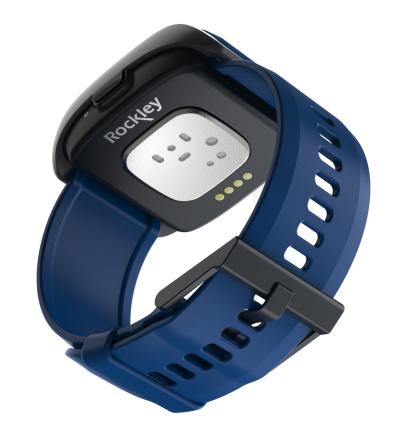In the latter half of 2022, Rockley Photonics announced that it had signed the first commercial purchase order for its Bioptx biosensor-tracking wearables, with hopes of getting them on the first customers’ wrists by the end of the year and plans to majorly boost manufacturing throughout 2023.
Things didn’t go according to plan, however, as Rockley kicked off 2023 by filing for Chapter 11 bankruptcy in January. Nearly a year later, after wrapping up the bankruptcy proceedings over the summer and, according to the company, emerging with all of its material customer contracts and tech development programs still in place, Rockley is ready to return to the process of finding buyers for its Bioptx sensor.
According to a Tuesday announcement, the techmaker has now begun “sampling” the wearable device and its associated cloud-based platform to prospective customers and partners.
The Bioptx biosensing band is a smartwatch-like device that uses both LED-based photoplethysmography (PPG) technology—which is found in other wearable devices, such as Masimo’s pulse oximeters and the Apple Watch—and Rockley’s own short-wave infrared (SWIR) laser-based spectroscopy, embedded in its miniaturized photonic integrated circuit (PIC) chips, to continuously and noninvasively track several biomarkers.

Currently, the wearable can monitor six data points: body hydration and temperature—which are measured using the SWIR technology—as well as heart rate, heart rate variability, respiratory rate and blood oxygen saturation, all of which rely on the standard PPG sensors.
Rockley’s technology hasn’t received FDA clearance. The company is branding the first iteration of the Bioptx band for more casual use, noting on its website that the devices are expected to be medical-grade starting with the second generation. For now, the measurements collected by the device “are not intended to diagnose or treat any medical condition or be used for any other medical purpose. They are intended to help people manage their well-being and keep track of their personal information,” Rockley said.
The connected platform, meanwhile, compiles all of the collected readings into a single cloud-based location. From there, researchers and companies using Rockley’s technology can access the data through the recently launched API Developer Platform. They can also adapt both the Bioptx hardware and software to fit into their own health-tracking needs.
“We are thrilled to usher in the next generation of health monitoring with wearable laser-based technology,” CEO Andrew Rickman, Ph.D., said in the announcement. “Rockley has created the full technology stack from the design of the PIC, which forms the miniature spectrophotometer, to the full wearable integration and novel biomarker delivery. We have significantly progressed the SWIR-tissue measurement science and biomarker algorithms through IRB-approved human studies.”
Rickman also hinted at future upgrades to the Bioptx technology, adding, “As we have recently demonstrated with our non-invasive glucose sensing and cuffless blood pressure studies, laser-based biosensors will continue to expand and enhance our understanding of human health.”
On the noninvasive glucose monitor front, preliminary results shared in September showed that Rockley’s technology was able to measure blood sugar levels with an accuracy of 5 mg/dL in one benchtop study, while an in-human test “demonstrated significant progress towards the development of a noninvasive wearable glucose monitor,” according to the company, without providing any further details about the study.
A month earlier, Rockley shared the preliminary results of another pair of studies: one conducted during a standard clinical visit, which proved its wearable technology was able to accurately track changes in blood pressure, and another that tasked the tech with tracking blood pressure over the course of about five weeks and which ultimately fell short of the desired outcomes.